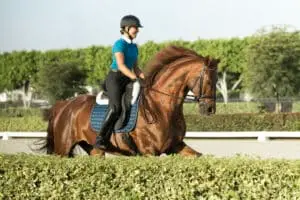
Straightening a horse—how do you do it
“Straighten your horse!”—every rider has probably heard this phrase from their instructor at least once.

How to Improve Your Seat
A horseback rider’s seat can have a great impact on the performance. Controlled legs can impove your seat immensly. Keeping your legs still is more about moving than staying still. The cause for this issue is usually the a trigger connected to other issues with your seat in the saddle. Riding instructors love to use the phrase “legs still!”.
The instruction to “keep your thighs still” will however almost certainly have the opposite effect. Therefore, it is difficult to break the pattern of knocking, rotating, or flapping the thigh. Holding still is neither practical nor simple to implement. The rider’s seat is a fairly unstable structure, and the less experienced a rider is, the more time they spend trying to balance themselves out. And an inexperienced rider tries to secure themselves in the saddle in a different way precisely when the balance is off. They either clamp with the thigh, hold on to the reins, or make up for the imbalance by maintaining a firm middle position, all of which result in the aforementioned wobbly leg.
The correct leg position is achieved almost automatic, when a rider sits in a well-balanced position with the appropriate balance of stability and the mobility in the middle posture. The legs will nevertheless immediately start to wobble if their middle pose is rigid.
Riders must be aware that the hip joint is a ball-and-socket joint. When riding loose from the hip, the hip is where the bones are connected from the rider’s trunk to their thigh, and this is often where the bad behavior of having a restless thigh starts. A brief look at human anatomy is helpful: There are five distinct types of joints in the human body: ball joints, saddle joints, pivot joints, and egg joints. The ball joint gives you the most mobility possible. It has a matching socket and a spherical joint head. Six distinct directions of movement are supported by the three movement axes: stretching and bending, spreading out and moving, and turning forwards and backwards. Only the shoulder joint, rather than the hip joint, permits such a wide range of motions. One thing becomes clear from this: The rider’s ability to feel the hip joint’s extreme mobility is invaluable.
It can be helpful to imagine sitting on a barrel and then moving and angling the joint between the foot and knee so that the hip moves automatically. You can sense how it feels to hug the horse’s trunk with your thigh this way. Recognizing the hip joint as a ball that can move in any direction is necessary to embrace the barrel. The horse’s hip must not be fixed. You will quickly realize that in order to hug the barrel with the leg, the knee must bend.
When on horseback, the knee isn’t always in a bent position. Excessively long stirrups can really obstruct your view from the seat and render stirrup kicking impossible. An ankle and knee angulation that is springy is made possible by the stirrup kick. It is essential that the stirrup is properly positioned under the ball of the foot rather than the toe’s tip. If you continue to fish for your stirrups with the tip of your toes, the stirrups are too long. When you let the leg hang loosely from the hip, picking up the stirrup shouldn’t take any extra effort. You won’t be able to keep the stirrup in place if you have to look for it while standing.
When you do not have to stretch your leg to reach the stirrups the stirrup length is correct. Your ankle and hip remain the most mobility if the stirrups are set to the correct length.
You may also require different stirrup lengths for different horses due to the torso’s circumference, which also affects the correct stirrup length. For instance, in order to reach the horse with his calf, a rider with long legs would buckle the stirrups a little shorter on a small horse.
But back to the thigh flapping: Specific anatomical conditions make it challenging for some riders to maintain a stable thigh position. For instance, it is significantly more challenging to bring a round thigh into the ideal position than a flat one. With the same leg length, the former will require a shorter stirrup than the latter. Basically, dressage riders sometimes ride with short stirrups, and show jumpers sometimes ride with longer stirrups, which is good for the individual seat and leg position.
An incorrect perception of the driving aids is another common cause of unsteady thighs. Technically speaking, the urge to provide driving assistance is triggered by the muscles in the rear thigh. They may be referred to as “driving muscles.” By lying on your back and swinging your heel toward your buttocks, you can locate them. You can feel the driving muscles at that moment, and the heel points to them.
For the horse, the driving rider aids are a real problem with an unsteady leg. A horse cannot distinguish between leg action in the sense of aiding and when the rider’s leg is just wobbling uncontrollably.
It is critical, particularly in this setting, to repeatedly and precisely release the leg from the horse. Taking the pressure off, or letting go of it, certainly makes the rider aware of how much stress the horse was under at the time. Driving isn’t a state that lasts forever. You as a rider need to give specific commands. Both the horse and the rider are unaware of these impulses if the leg is not released. In the end, constant pressure dulls it. However, impulses shouldn’t cause the thigh to thump incessantly. That would also have the effect of dulling.
Riders who have trouble sitting can also benefit from choosing a slower pace. You can either ride at a slower pace or do a lot of trot-walk transitions to get a better feel for the right position. The stride recesses are meant to be used for relaxation but also to adjust one’s own position in the seat. You must parry without pulling on the reins, reorganize your seat, and slowly attempt to swing into the movement as the horse trots off. This aids you and the horse in finding your equilibrium.
Additionally, you will gain a better understanding of how to let go of your horse without having to direct every step, kick, and jump. You can instead focus on moving smoothly in the middle position. Contrary to popular belief, flapping thighs do not require much attention. Improving your overall seat will automatically better the problem of unsteady thighs.
Download the Happie Horse App for free and get a 7-Day free trial to test all the Premium Features!

“Straighten your horse!”—every rider has probably heard this phrase from their instructor at least once.
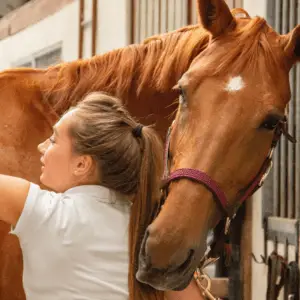
Upgrade your routine! Keeping your horse in tip-top shape is crucial for his health and
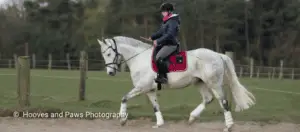
These exercises will help you get fit in the saddle in the future What you
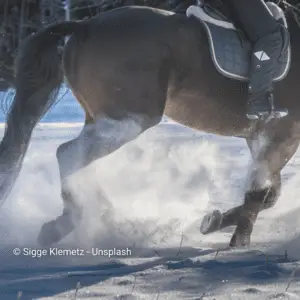
How to Improve Your Seat A horseback rider’s seat can have a great impact on
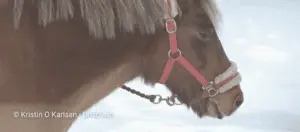
Wintercare for Horses Riding in winter can be challenging, both for the rider and the

Improve Your Horse’s Training in the Cold Months Dressage riding is a discipline that requires